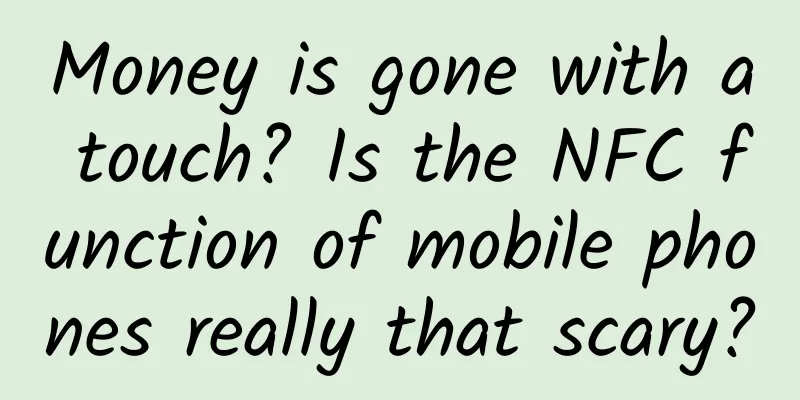Money is gone with a touch? Is the NFC function of mobile phones really that scary?

|
Not long ago, some videos appeared on the Internet, claiming that money was stolen because the NFC function on the mobile phone was turned on. So, what is NFC? Is it really possible to steal money just by touching it? Let me start with the conclusion: NFC itself is a normal function of current smartphones. In the entire fraudulent process, "touch and pay" is just the final step after a lot of preparation. As long as you pay a little attention when using it, there is no need to abandon the NFC function. Of course, if some friends don't know much about this technology and are worried that they can't deal with fraudsters' fraud, this article will also explain how to turn off the relevant function at the end. Let’s start with what NFC is. What exactly is NFC? To explain what NFC is, we have to talk about RFID first. Its full name is Radio Frequency Identification. You may be unfamiliar with this name, but I believe you must have come across it in your daily life. The access cards used in community office buildings and the ETC payment used on highways are all based on RFID technology. The working principle of RFID technology can be understood as follows: the reader emits electromagnetic waves through the antenna. When a passive tag (such as an access card) enters the sensing range, its internal coil will generate a microcurrent due to electromagnetic induction. With this wireless power supply method, the tag is "activated" and exchanges data with the reader, ultimately realizing functions such as identity recognition and payment verification. One of the beauties of this technology is that the tag itself that needs to be read does not need to be powered at all times. Sun Haixia, Xue Ru. Composition and working principle of RFID system[J]. Tibet Science and Technology, 2005, (09): 59-60. This is why our access control cards are so thin and light—RFID technology allows them to communicate with the access control system without the need for an additional power source. Some RFID devices work over very long distances, such as the ETC used at toll booths, which can exchange data at a distance of about 10 meters. Such technology is certainly very convenient, but if the data exchange is as effective as ETC over a long distance, serious problems may arise when we use it to pay in our daily lives - when we take out our phone, we end up paying the bill at the store next door... It is then that NFC comes into play. The principle of NFC is very similar to that of RFID, except that it can not only perform one-way identification, but also exchange data. The full name of NFC is near-field communication technology, and its name well explains the characteristics of this technology. Generally, data can only be exchanged within a range of 20 cm or even shorter. And it is precisely because NFC can only exchange data at a very short distance that it has natural security and can be used relatively well in mobile payment scenarios. Copyright images in the gallery. Reprinting and using them may lead to copyright disputes. For example, many bank cards support NFC. If you use a bank card or a mobile phone bound to a bank card in a shopping mall, you may find that merchants no longer need to "swipe" the card as in the past, but simply put the cash register close to your bank card or mobile phone to read the information for the transaction. In addition, some mobile phones can directly use the NFC function to swipe bus cards, which is very convenient when riding. Therefore, mobile payment technology based on NFC is not new and has been used for a long time. There are also many mobile phones that can use the NFC function on the mobile phone to swipe bank cards through the mobile phone. Should NFC be blamed for credit card fraud? Not long ago, there were indeed some news related to "NFC fraud", and some news titles were even "Mobile phone NFC function has become a scammer's ATM", but these titles may have exaggerated the responsibility of NFC. Most of the news related to "NFC fraud" refers to two incidents, which are briefly described as follows: The first case was that Mr. Li received a call from someone claiming to be an airline customer service representative. He downloaded a software called "NFO-X" and made several transactions according to the instructions. During the transaction, Mr. Li was instructed by the fraudster to use the NFC function of his mobile phone to swipe his bank card, and was defrauded of 98,000 yuan by the fraudster. Screenshots of the two incidents The second incident was that Ms. Luo received a strange phone call, claiming that she had subscribed to a paid service. In order to cancel the service, Ms. Luo also followed the scammer's instructions to download two softwares, and even turned on the screen sharing function, allowing the other party to remotely operate her phone. In the end, she also used the NFC function of her phone to swipe her bank card, and the scammer transferred the money in her bank card. As long as you read the descriptions of these two incidents, you will find that the entire fraudulent process is not what people imagine, where the bad guys simply hold the machine close to the mobile phone or bank card to swipe our money. Copyright images in the gallery. Reprinting and using them may lead to copyright disputes. The key to money being stolen is not that the mobile phone has NFC function, but that people easily believe what strangers say, download software from unknown sources, and even allow strangers to directly control their mobile phones. Therefore, instead of worrying about "NFC fraudulent payment", the key is to enhance anti-fraud awareness and not download unknown software. Of course, it is undeniable that it is good to be vigilant in financial transactions. If you are really worried about the safety risks of touching the phone, you can also turn off the NFC function of the phone, or turn off the small amount of password-free payment function, so you don't have to worry about your money being "touched" away. Here is how to turn off NFC. Android/Hongmeng system (left) Click the NFC icon in the drop-down menu. For Apple phones, you can find the switch in Settings → General → NFC Will “tapping” cause your money to be stolen? Not long ago, many offline stores have seen devices with the "touch and pay" function. This device no longer requires scanning or showing the payment code. Just unlock the phone and place it on the sensing area to complete the payment, which is indeed more convenient. But some people also took a video saying that 500 yuan was stolen from the card because of the "touch and pay". The Alipay Security Center responded on Weibo on January 23 that the video was staged. The blogger who staged the rumor also issued an apology statement to clarify the matter and will be punished by law. In fact, on the one hand, applying for this type of "touch and go" payment device requires merchant identity authentication, and it cannot be applied for at will. And certified merchants use the applied devices to swipe other people's phones everywhere, which is too easy to be detected. To put it another way, even if someone somehow gets a hold of the handheld device, the "touch and go" feature can only be enabled when the phone is unlocked, so it is impossible for someone to "touch and go" your money while the phone is in your pocket. And when the phone is unlocked, it must be "zero distance contact" in the literal sense. It is too suspicious to see a stranger holding something against your phone. In conclusion, the security technology for offline mobile payment is now quite comprehensive, and we can enjoy this convenience. However, we should pay attention to the following points: first, do not listen to suspicious calls, install apps from unknown sources on your phone, or give it to others for remote control; second, for those relatives and friends who do not know much about safe use of mobile phones and safe payment, we can remind them not to trust scammers and turn off these functions that may give scammers opportunities. Planning and production Author: Science Scraps Popular Science Writer Review丨Liang Zhongwei, Vice Dean of the School of Mechanical and Electrical Engineering, Guangzhou University Planning丨Ding Zong Editor: Ding Zong Proofread by Xu Lai and Lin Lin |
>>: Emergency consultation: Who sealed Shen Gongbao's throat?
Recommend
3 steps for Xiaohongshu brands to seize the traffic trend
According to data from the Ministry of Civil Affa...
Read the full text of The Widowed Sister-in-law novel for free, and read the full text of The Rural Widowed Sister-in-law for free without pop-ups!
Introduction to the novel of the widowed sister-i...
Mushicheng manager class courses, Mushicheng e-commerce college official website!
Mushicheng manager class courses, Mushicheng e-co...
2020 WeChat annual bill is online! Netizen: Am I so rich? ? ?
It's the end of the year again. Have you ever...
One picture to understand|A full moon story of a "business trip" in space
October 16, 2021 00:23 Shenzhou 13 manned spacecr...
Yaya is home! What "compulsory courses" will it take after returning home?
Compiled by New Media Editor Wang Shan Yaya is ho...
In-depth analysis of advertisers’ buying volume in the education and training industry in 2019!
Since 2017, live classes have emerged and the bus...
Switching between HStack and VStack in SwiftUI
Preface SwiftUI’s various stacks are the most bas...
Where did the ancient forests that did not turn into coal eventually go?
In the heavy rain, a group of Placerias slowly wa...
Zhang Yanhua sells goods through live streaming, and can earn over 100,000 yuan a month from her side job starting from scratch
Zhang Yanhua sells goods through live streaming. ...
The zebra has stripes only on half of its body. Is it because the printer is out of ink?
Densely packed animal skeletons, bizarre animal s...
SAIC Motor delivered 750 “government reception vehicles” to the CIIE
(October 12, 2024, Shanghai) Today, the "Del...
Question: Who stole my cell phone signal?
As a communications engineer, I am often asked th...
How much does it cost to customize a gaming device applet in Ordos?
In order to better penetrate into various industr...
Why can iPhone X only store one face at a time? Apple responds
If you want to save all the faces of your loved o...









